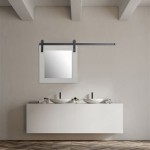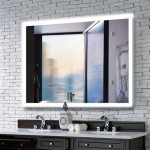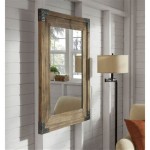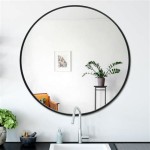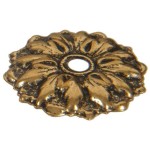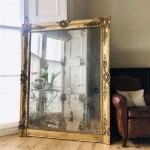How To Put A Heavy Mirror On Wall
Hanging a heavy mirror requires careful planning and execution to ensure both safety and stability. Improper installation can lead to damage to the wall, the mirror itself, or even injury. This guide outlines the necessary steps and considerations for successfully mounting a heavy mirror.
Assessment and Preparation: Begin by accurately measuring the mirror's dimensions and weight. This information is crucial for selecting appropriate hanging hardware and determining wall suitability. Examine the wall material. Drywall requires different hardware than masonry or concrete. Locate wall studs using a stud finder. Mark their positions for reference. If the mirror's weight exceeds the recommended capacity of standard drywall anchors, mounting directly to wall studs is essential.
Choosing the Right Hardware: The hardware must be capable of supporting the mirror's weight. For heavier mirrors, consider using D-rings or heavy-duty wire with appropriately rated picture hangers. French cleats offer a robust solution for especially large or heavy mirrors. Toggle bolts or heavy-duty anchors are suitable for drywall installations where stud placement isn't ideal. Consult the hardware packaging for weight limits and follow manufacturer recommendations.
Marking and Positioning: Decide on the desired mirror placement and mark the wall accordingly. Use a level to ensure the markings are perfectly horizontal. This prevents the mirror from hanging crooked. Measure the distance between the mirror's hanging hardware (D-rings, wire, or cleat) and transfer these measurements onto the wall markings. This ensures accurate placement of the wall hardware.
Installing the Wall Hardware: If using D-rings or wire, install the appropriate picture hangers on the wall at the marked locations, ensuring they are securely fastened. For French cleats, the cleat system consists of two parts. One part is attached to the wall, and the mating part is attached to the back of the mirror. Ensure both parts are level and securely fastened. For drywall installations without stud access, drill pilot holes and install the chosen anchors or toggle bolts according to the manufacturer's instructions. Ensure the anchors are flush with the wall surface.
Mounting the Mirror: With the wall hardware securely in place, carefully lift the mirror and align the hanging hardware with the wall-mounted hardware. For D-rings, simply hang the rings onto the hooks of the picture hangers. For wire, place the wire over the hooks. For French cleats, engage the two parts of the cleat system, ensuring a secure connection. For heavy mirrors, having an assistant is highly recommended to prevent accidents and ensure proper alignment.
Safety Precautions: Wear appropriate safety gear, including gloves and eye protection. Heavy mirrors can be difficult to manage, so ensure adequate assistance is available. Never attempt to lift a mirror beyond your physical capabilities. If the mirror is exceptionally large or heavy, consider using lifting straps or suction cups to aid in the process. Double-check the stability of the mirror after hanging to ensure it is secure. Conduct a gentle shake test to confirm the hardware is holding the mirror firmly in place.
Alternative Hanging Methods: Adhesive mounting systems are available for certain types of mirrors and wall surfaces. However, these systems are generally not recommended for very heavy mirrors due to potential adhesion failures. Consulting the manufacturer's recommendations regarding weight limits and suitability is crucial before using adhesive methods. These systems often require specific surface preparations and curing times for optimal adhesion.
Dealing with Irregular Walls: Uneven or textured walls can present challenges when hanging heavy mirrors. Shims can be used to compensate for minor irregularities and ensure the mirror hangs flush against the wall. Thick padding or foam can be added to the back of the mirror to provide additional support and prevent rocking. For significantly uneven walls, professional assistance may be necessary to ensure proper installation and prevent damage.
Specialized Mirror Hanging Hardware: Various specialized hardware options are available for specific mirror types and installation scenarios. Mirror mounting clips offer a discreet and secure method for hanging frameless mirrors. Security hardware is available for public spaces where theft or vandalism is a concern. For exceptionally large or heavy mirrors, custom-designed hanging systems may be required. Consulting with a professional installer or hardware specialist is recommended for complex installations.
Considerations for Different Wall Types: Drywall is a common wall material but may not be suitable for extremely heavy mirrors without reinforcement. Mounting directly to wall studs provides the strongest support. For masonry or concrete walls, specialized anchors and drill bits are required. Always consult the hardware manufacturer's instructions for proper installation techniques for different wall types. The wall's load-bearing capacity must be considered when hanging heavy objects.

How To Hang A Heavy Mirror The Home Depot

How To Hang A Large Or Heavy Mirror
How To Hang A Heavy Mirror On Drywall Quora

How To Hang A Heavy Mirror Lowe S

Hanging Heavy Mirror On Plaster Walls 6 Steps With Pictures Instructables

How To Hang A Heavy Full Length Leaner Mirror On The Wall House Of Hepworths

How To Hang A Heavy Mirror The Home Depot

How To Hang A Heavy Mirror The Home Depot

Hanging Heavy Mirror On Plaster Walls 6 Steps With Pictures Instructables

How To Hang Something Heavy Like A Pro Calling It Home Diy Improvement Projects Hanging Mirror

